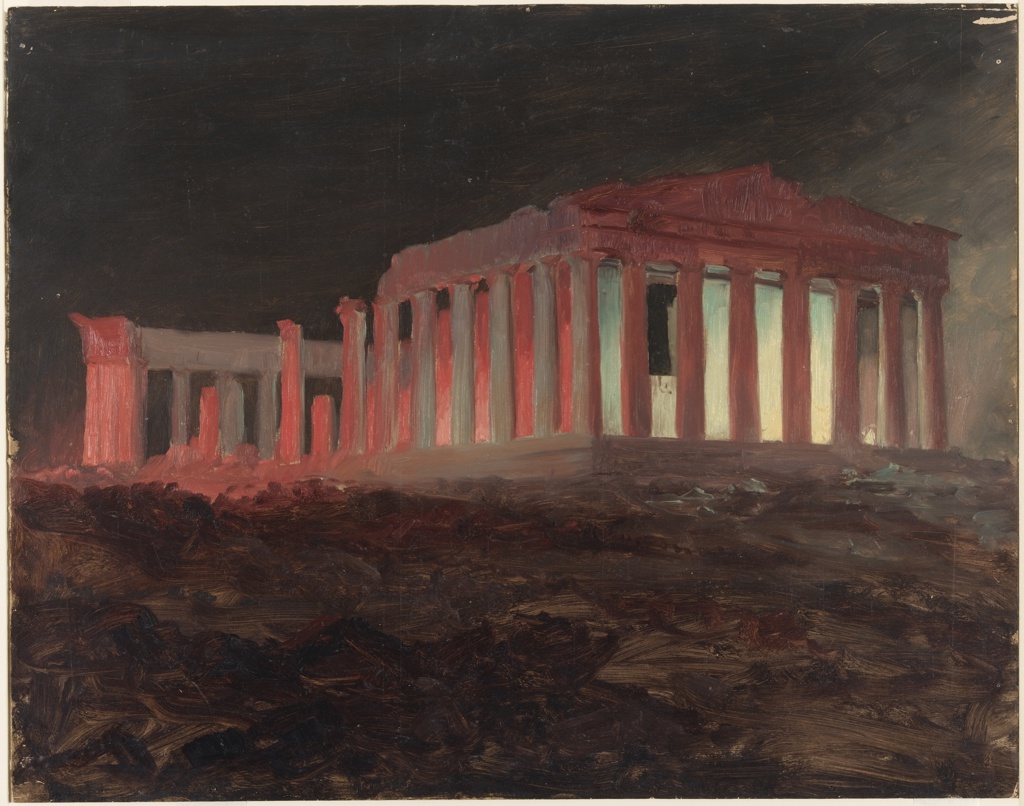There are 2 other images of this object. This image is in the public domain (free of copyright restrictions), and as such we offer a high-resolution image of it. See our image rights statement.
See more objects with the color darkslategrey darkslategrey saddlebrown dimgrey dimgrey or see all the colors for this object.
Object Timeline
|
-0001 |
|
|
1917 |
|
|
1970 |
|
|
2005 |
|
|
2012 |
|
|
2014 |
|
|
2025 |
|
Drawing, Parthenon at Night, Athens
This is a Drawing. It was created by Frederic Edwin Church. It is dated April 1869 and we acquired it in 1917. Its medium is oil and graphite on tan paperboard. It is a part of the Drawings, Prints, and Graphic Design department.
Hauntingly Beautiful: Frederic Edwin Church’s Parthenon Sketch
Home of the mythological goddess Athena, the Parthenon is a hauntingly sacred place where the air is ominously rife with magic. Or, at least, that is the mood evoked in Frederic Edwin Church’s (1826-1900) oil sketch of the Parthenon. To create this effect, Church chose to paint the building from below, giving the impression that it looms over the viewer. In reality, this particular view of the Parthenon does not exist, but is rather contrived from composite views and memory. The contrast of red and blue illumination was also almost certainly invented by the artist. Church used a similar technique while painting icebergs along the Labrador coast. Church’s occasional use of artificially-colored lighting suggests that the lighting in this particular sketch was also introduced by him for dramatic effect.
Church’s artistic career began by faithfully reproducing the American wilderness in the Berkshires, Vermont, New Hampshire, and New York. From 1844 until 1846, he learned to paint from Thomas Cole and became the star pupil of the Hudson River School artist. Church began creating his own compositions from memory rather than painting actual scenes from nature. This gained him international acclaim. Part of the American Romantic movement in the 19th century, Church sought to create feelings of both awe and fear within his work. In April 1869, he sailed to Greece, where he was amazed by the Parthenon. He called it “the culmination of the genius of man in architecture,” and sought to create a painting that captured the majesty of the structure.This sketch was actually a study for the final painting in the Metropolitan Museum of Art’s collection.
After 1870, Church’s pace slowed and his rheumatoid arthritis, diagnosed in 1876, severely limited his ability to paint. When he was no longer active, his fame dwindled and his death, in 1900, passed unnoticed. In the last sixty years, Church’s works have experienced a resurgence in popularity. Cooper-Hewitt, National Design Museum holds more than 2,000 oil sketches and graphite drawings—the largest collection of works by Church in the world.
This object was featured in our Object of the Week series in a post titled Hauntingly Beautiful: Frederic Edwin Church’s Parthenon Sketch .
This object was
donated by
Louis P. Church.
It is credited Gift of Louis P. Church.
- Frieze (France)
- block-printed and stenciled on machine-made paper.
- Gift of Eleanor and Sarah Hewitt.
- 1931-45-80
- Painting, Broken Column, Parthenon
- brush and oil paint, graphite on paperboard.
- Museum purchase from General Acquisitions Endowment Fund.
- 2018-36-1
- Trifoglio Vase
- pvc plastic.
- 1991-108-11
Our curators have highlighted 5 objects that are related to this one. Here are three of them, selected at random:
- Drawing, Classical Ruins, Syria
- oil paint and graphite on paperboard.
- Gift of Louis P. Church.
- 1917-4-1081
- Drawing, The Parthenon at Sunset, Athens
- oil and graphite on paperboard.
- Gift of Louis P. Church.
- 1917-4-507-b
- Drawing, The Parthenon Lighted at Night, Athens, Greece
- graphite on gray-green wove paper.
- Gift of Louis P. Church.
- 1917-4-326-b
Its dimensions are
32.9 × 41.4 cm (12 15/16 × 16 5/16 in.)
It has the following markings
Stamped: in black ink, verso center, L.457d
Cite this object as
Drawing, Parthenon at Night, Athens; Frederic Edwin Church (American, 1826–1900); USA; oil and graphite on tan paperboard; 32.9 × 41.4 cm (12 15/16 × 16 5/16 in.) ; Gift of Louis P. Church; 1917-4-671
This object was previously on display as a part of the exhibition Hewitt Sisters Collect.






